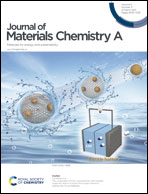A high-flux organic solvent nanofiltration membrane with binaphthol-based rigid-flexible microporous structures†
Abstract
Highly permeable organic solvent nanofiltration (OSN) membranes are desired to be used in an efficient and energy-saving chemical separation process. Herein, we fabricated a high-flux OSN membrane by synthesizing 7,7′-dihydroxy-2,2′-binaphthol (7,7′-OH-BINOL) as an aqueous phase monomer to react with trimesoyl chloride (TMC) via interfacial polymerization. The unique structures of 7,7′-OH-BINOL having a rotatable highly kinked unit and a rigid binaphthol ring endow the fabricated polyarylate membrane with very high microporosity and super-high Young's modulus. Both simulated and experimental results demonstrate that the BINOL-based polyarylate (PAR-BINOL) membrane has two types of micropores including cross-linked pores and stacked pores. Our results find that the PAR-BINOL membrane exhibits very high solvent permeance over a wide range of solvents with diverse polarity, and also possesses a long-term stable separation performance in solvents. Impressively, the membrane solvent permeance can reach up to 28.7 L m−2 h−1 bar−1, 9.2 L m−2 h−1 bar−1 and 6.7 L m−2 h−1 bar−1 for acetone, methanol, and dimethylformamide (DMF), respectively. The rejection of tetracycline (TC, Mw = 444 g mol−1) is 98.2%. Our work provides some insights into the molecular engineering of monomers with unique contorted and rigid structures for the fabrication of highly permeable OSN membranes.



 Please wait while we load your content...
Please wait while we load your content...